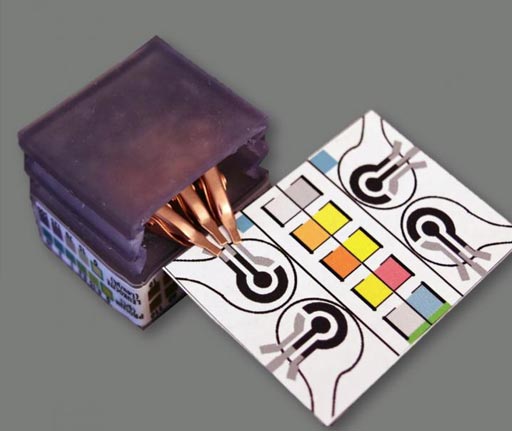Disposable POC Device Introduced for Low-Resource Areas
By LabMedica International staff writers
Posted on 06 Sep 2017
A recent paper described a novel diagnostic device fabricated from various types of paper to be used for point-of-care testing in areas lacking electricity and other resources.Posted on 06 Sep 2017
The developers at Purdue University (West Lafayette, IN, USA) used different types of paper to fabricate Self-powered, Paper-based Electrochemical Devices (SPEDs) that were designed for sensitive diagnostics in low-resource settings. SPEDs are inexpensive, lightweight, mechanically flexible, easy to use, and disposable by burning.

Image: Paper-based diagnostic device that detects biomarkers and identifies diseases by performing electrochemical analyses. The assays change color to indicate specific test results. The device can be plugged into the handheld potentiostat, at left (Photo courtesy of Purdue University, Aniket Pal).
The top layer of the SPED was prepared from cellulose paper with patterned hydrophobic domains that delineated hydrophilic, wicking-based microfluidic channels for accurate colorimetric assays, and self-pipetting test zones for electrochemical detection.
The bottom layer of the SPED was a triboelectric generator (TEG) made from hydrophobic paper and capable of harvesting electrical energy from the user's interaction with the SPED.
An inexpensive and rechargeable handheld potentiostat was constructed to interface with the SPED, enabling the accurate quantitative electrochemical detection of glucose, uric acid, and L-lactate. The battery powering the potentiostat could be recharged by the user, using the sequential discharge of a capacitor previously charged with the TEG built into the SPED.
A machine-vision diagnostic application was created to automatically identify and quantify each of the colorimetric tests from a digital image of the SPED, taken under a wide range of ambient light conditions, in order to provide fast diagnostic results to the user as well as to facilitate remote expert consultation.
"To our knowledge, this work reports the first self-powered, paper-based devices capable of performing rapid, accurate, and sensitive electrochemical assays in combination with a low-cost, portable potentiostat that can be recharged using a paper-based TEG," said contributing author Dr. Ramses V. Martinez, assistant professor of industrial and biomedical engineering at Purdue University. "You could consider this a portable laboratory that is just completely made out of paper, is inexpensive and can be disposed of through incineration. We hope these devices will serve untrained people located in remote villages or military bases to test for a variety of diseases without requiring any source of electricity, clean water, or additional equipment."
SPEDs were described in detail in the August 22, 2017, online edition of the journal Advanced Materials Technologies.
Related Links:
Purdue University













